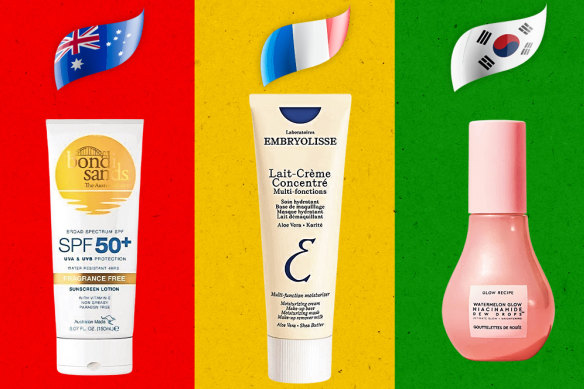By Nell Geraets
Skincare seems universal. A moisturiser, for example, will be hydrating no matter where it’s from. But it’s far more culturally specific than it may appear, driven by distinct philosophies and goals in different countries.
So, why not put those differences to the test? In honour of the fast-approaching Olympic Games in Paris, we’ve decided to throw three heavy-hitting skincare nations – France, South Korea and Australia – into the ring to fight for gold.

When it comes to skincare, which country will come out on top?Credit: Compiled by Marija Ercegovac.
Contestant #1: France
According to Emilie Roberson, co-founder of Australian-based online retailer French Beauty Co., French skincare prioritises simplicity.
“In its purest form, it’s simple, minimal and effortless. Instead of an intensive 12-step routine, we follow a less-is-more approach,” Roberson says. “We also believe in multipurpose products, delivering more for your buck.”
The accessibility of these products is crucial, Roberson adds, noting that most can be found at affordable prices in French pharmacies rather than spread around supermarkets, boutiques and luxury stores. The products will also generally be relatively traditional and consistent.
“French skincare is not dictated by trends,” Roberson says. “It’s not about the quick fix, it’s about longer-term results. And because they’re sold at pharmacies, you know they’ve been carefully formulated for sensitive skin.”
Notable products
Embryolisse: This brand is renowned for its multipurpose products, such as the Lait-Crème Concentré, which is a moisturiser, mask, cleanser, make-up primer, after-shave balm and after-sun soother.
SVR: Roberson says these products contain a high percentage of active ingredients (such as retinol and vitamin C) and don’t use any endocrine-disrupting ingredients that may interfere with the body’s hormones.
Contestant #2: South Korea
Unlike in France, South Korea tends to opt for the maximalist approach, with some people following a 10-step daily skincare routine. Though the number of products used is plentiful, they’re generally affordable, with certain higher-end exceptions like luxury brand Sulwhasoo.
Sarah Tarca, co-founder of the beauty newsletter gloss etc., says the goal is glass skin, meaning most products are geared towards hydration.
“TikTok rebranded this approach as skin flooding, but it’s the same principle: using multiple products to quench the skin through its many layers, and give the skin a plumped-up, springy look and feel.”
K-Beauty proliferated on TikTok because of its colourful packaging and highly innovative nature, says dermal therapist James Vivian. Some products contain snail mucin, horse oil and bee venom – all unique ingredients that create intrigue while promising specific results. Others are more experimental in terms of application, such as boba cream, which allows users to pop boba balls on the face to release moisturiser.
Notable products
Glow Recipe: “Cheeky copy, cute names and enticing bottles make for alluring and enticing experiences that go beyond skincare,” Vivian says.
Innisfree: These products use interesting ingredients like Jeju volcanic powder, and are offered at very reasonable prices, Tarca says.
Contestant #3: Australia
Protection is key in Australian skincare, says Hannah English, a beauty scientist and author of Your Best Skin. Due to high UV exposure across the country, Australian SPF products have become renowned for their protection against sunburn, as well as their long-lasting wear.
Many Australians favour local products that use natural and native ingredients, English says, including kakadu plum and finger lime.
They’re also usually more intentional in terms of the age groups they target, English adds. “Boost Lab, for example, targets Gen X women. No brand was really talking to women over 40 … So now people are really into it, and you can even find it at Priceline.”
Meanwhile, tbh skincare appeals to Gen Z and millennials by making anti-acne products colourful instead of clinical, as well as marketing products on TikTok using viral trends.
Overall, Tarca says most brands appeal to Australians’ “straight-to-the-point” nature. “Aussie culture isn’t fluffy, so the brands that resonate remove the jargon and deliver great products in a fun – and often funny – way.”
Notable products
Bondi Sands: This line is known for its sunscreen and retinol serum, English says, which only costs around $23.
Go-To: This brand, owned by Zoe Foster Blake, markets its products in an approachable and humorous way, Tarca says.
Final rankings
Skincare is ultimately subjective, and preferences will differ depending on what an individual needs. However, after conferring with the expert panel, one country still dominates overall.
Bronze: Australia
While every expert praises Australia for its focus on sun protection, they concede the country is still relatively new to skincare compared to its competitors, and therefore lacks as wide a range (though this is changing).
Silver: South Korea
Thanks to its innovative ingredients, trendy packaging, wide variety and affordability, South Korea takes second place.
Gold: France
Vivian sums it up best: “This is where skincare began. We must pay homage to our roots. They also win because of the availability of great skincare at local pharmacies all over the country.”
Make the most of your health, relationships, fitness and nutrition with our Live Well newsletter. Get it in your inbox every Monday.